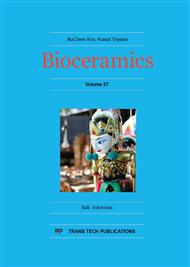p.165
p.171
p.177
p.183
p.187
p.192
p.196
p.205
p.212
Highly Porous β-TCP Block with Triple Pore Structure in Rat Subcutaneous Tissue and Sheep Iliac Critical Bone Defect
Abstract:
Bio-absorbable materials have been strongly needed in bone regenerative surgery. β-TCP ceramics have been widely used as bone tissue scaffold materials, due to their bio-compatibility and bio-degradation. The aims of this study are to estimate blood permeation into different porous β-TCP blocks (75% and 67% in porosity), and to evaluate the behaviors of the 75% porous β-TCP block in rat subcutaneous tissue and sheep iliac bone defect by histological observation and 3-dimensional (3D) imaging analysis by μ-CT. The 75% β-TCP block revealed better performance in blood permeation than the 67% β-TCP in a dish including 3ml of sheep blood at 2 and 10 minutes. Almost area of the 75% β-TCP block turned to red at 10 minutes. In rat subcutaneous tissue, the bulk region of the 75% β-TCP was stained with HE. TRAP-positive multinucleated giant cells appeared on the surface of bulk at 4 weeks. In sheep iliac bone defect (10×15×9 mm3) model, μ-CT showed bone ingrowth into almost pores of the 75% β-TCP block at 2 months, and the block was absorbed and replaced by new bone until 4 months. The block was reduced to one-third in horizontal length and from 10 mm to 4 mm in vertical length at 2 months by 3D images. Body fluid stained by HE was found in the bulk region. We believe the body fluid permeation inside the bulk of the 75% porous β-TCP should contribute to the initial cell adhesion, proliferation and differentiation, and its biodegradation. It was concluded that the super porous β-TCP block with hydrophilic property might be a biological scaffold, harmonized with bone remodeling.
Info:
Periodical:
Pages:
187-191
Citation:
Online since:
May 2016
Keywords:
Price:
Сopyright:
© 2016 Trans Tech Publications Ltd. All Rights Reserved
Share:
Citation:


